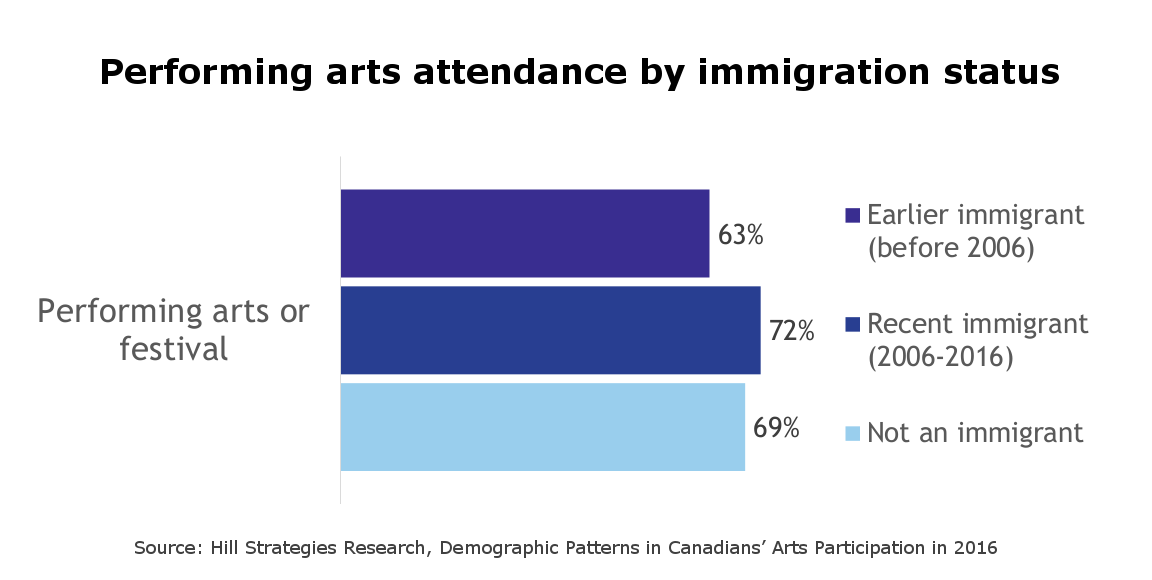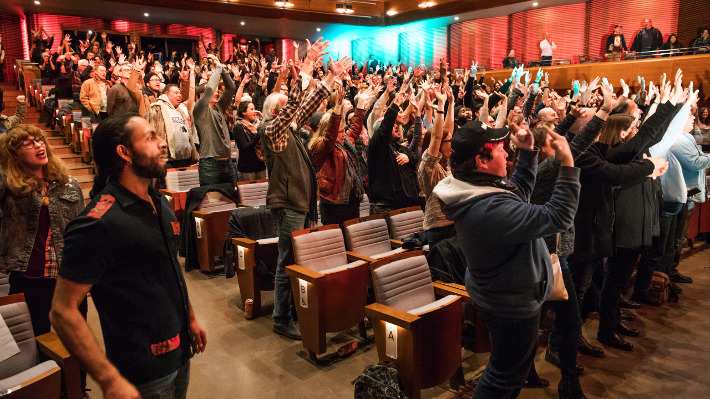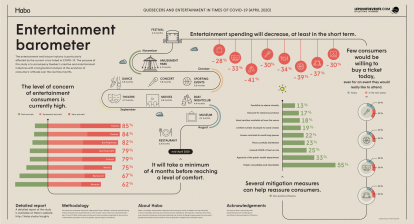February 5, 2020 – If you are under the impression that the performing arts cater mostly to middle-aged white audiences, it’s perhaps time to revise your assumptions. Statistics shared by Hill Strategies Research reveal that attendance at the performing arts is prevalent across all segments of the Canadian population.
The performing arts reach lots of Canadians : 68% attended an arts performance or festival in 2016, according to Statistics Canada’s General Social Survey.
As Kelly Hill explained during a webinar on Demographic Patterns in Canadians’ Performing Arts Participation, arts attendance tends to increase with education and income. But attendance is nonetheless strong among many demographic groups who are not typically associated with income privileges: young Canadians, Indigenous people, racialized groups, and immigrants.
Kelly Hill noted that content matters. Each demographic group exhibits preferences for certain types of events. In particular, Indigenous, racialized, and immigrant Canadians report significantly higher attendance rates at “heritage and ethnic performances” than other Canadians. “Other types of performances”, a none-of-the-above category that may include dance performances as well as any hard-to-classify event, are also popular among racialized and immigrant Canadians.
Interestingly, not all immigrants attend at the same rate. Recent immigrants (landed between 2006 and 2016) tend to have much higher attendance rates than earlier immigrants.

This difference in attendance rates between recent immigrants and earlier immigrants is a critical data point from the perspective of audience diversification. What sense can we make of this churn rate? Does it mean that recent immigrants are initially curious to discover their new country, but that this curiosity fades after a few years? Could it imply that programs to entice newcomers to events are effective but don’t have a lasting impact? What could be done to ensure that performing arts attendance by immigrants remains high as years go by?
Kelly shared a few pointers from other data sources:
- The Diversity and Drivers of Arts Attendance report revealed that “feeling welcome” is the top motivator of frequent attendance. What could performing arts organizations do to ensure that recent immigrants are feeling welcome when they walk into their venue for the first time?
- In the Arts and Heritage Access and Availability survey, Indigenous people and immigrants were more likely to strongly agree that arts and heritage experiences help them feel part of their local community. Similarly, the Diversity and Drivers report also found that “connecting to my community” is a strong motivator of frequent attendance. How can performing arts organizations foster this sense of community connection and what impact could this have on attendance by immigrants and Indigenous people?
- Representation matters. In the Arts and Heritage Access and Availability survey, reported attendance at performances by visible or ethno-cultural minorities is highest among individuals who identify their own ethnicity as “other than Canadian or European” (55%). In the same vein, attendance at a performance given by First Nations, Inuit or Métis artists is particularly high among Indigenous people (60%, vs. 21% of non-Indigenous Canadians).
Towards the end of the webinar, Kelly Hill shared demographic projections illustrating that racialized, immigrant, and Indigenous people will continue to represent growing shares of the Canadian population over the next fifteen years. He concluded his webinar with these words of advice: “If you’re not reaching many youth, Indigenous people, racialized people, and immigrants, think about your programming, marketing, and communications.”
Resources from the webinar
This webinar was hosted by Ontario Presents and CAPACOA, on behalf of the Performing Arts Alliance on December 11th, 2019. Kelly Hill’s presentation was made possible thanks to support from the Department of Canadian Heritage, the Canada Council for the Arts, and the Ontario Arts Council as part of their funding commitment to the Statistical Insights on the Arts series.
This webinar was also presented in French, on January 30th, 2020.
Recommended audience research reports
Demographic Patterns in Canadians’ Arts Participation in 2016 (2019)
Vitality and Impact of Arts Presenting (2019)
Diversity and Drivers of Arts Attendance (2019)
Culture Track Canada (2018)
Arts and Heritage Access and Availability 2016-2017 (2017)
Focus groups on Canadians’ participation in the arts : final report (2018)
Related News
Live Performances: the Social Paradox and the Welcoming Factor




